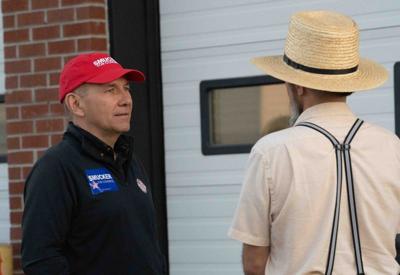New Holland farmer Amos King canvassed on behalf of the Republican Party for the first time this year, helping to mobilize dozens of Amish voters for President-elect Donald Trump.
King, 63, speaks Pennsylvania Dutch and was raised New Order Amish after his family left the Old Order when he was 6. Though he voted by mail because he was traveling on Election Day, he said his family helped shuttle Amish voters to polling locations throughout the day.
“It didn’t matter if it was morning or afternoon, there were just swarms of Amish voters,” King said. “We take Amish people … every election, but there was nothing like it this year.”
King wasn’t alone in making that observation. Some Republican Party organizers and activists claimed in the immediate wake of the election — without much more than anecdotal evidence — that the Amish turned out in droves for Trump, helping cement his victory in Pennsylvania.
But researchers at Elizabethtown College’s Young Center for Anabaptist and Pietist Studies said it’s too early to say definitively whether the Amish, who historically vote in small numbers, set any records this year.
“Were there more Amish voters in Lancaster County than in 2020? Undoubtedly, but we won’t know how many for some time,” said Steven Nolt, a professor of history and Anabaptist studies at Elizabethtown College.
It will take at least several months for Nolt and his team to estimate Amish voter turnout. They do so by comparing names, addresses and birthdays on voter rolls to Amish church directories.
Nolt said it’s difficult to see how the Amish were “decisive in flipping Pennsylvania,” a state Trump won by roughly 139,000 votes, as of Friday. Statewide, the total Amish population is estimated to be less than 93,000.
Yet political organizers like Scott Presler, who led some “stop the steal” efforts following the 2020 election, insist the Amish vote was key to Trump’s win this year.
“President Trump won MORE votes out of Lancaster County than in 2020,” Presler posted on X on Tuesday. “The Amish delivered.”
Presler led one of the many GOP efforts before the election in Lancaster County — involving canvassing, billboards and other advertising — to promote Amish voter registration and participation, as previously reported by LNP | LancasterOnline.
His outreach organization, Early Vote Action, hosted near-weekly voter registration drives at the Green Dragon Market in Ephrata Township and Root’s Country Market & Auction in East Hempfield Township. He said his group registered “thousands” of Amish, but he did not elaborate.
Slight boost in Amish areas
The Amish community certainly contributed to Trump winning more votes in Lancaster County this year – 165,051 – than he did in 2016 or 2020, when he won 137,914 and 160,209, respectively.
However, an LNP | LancasterOnline analysis of more than 20 precincts where Amish communities are concentrated found only marginal gains for Trump in those locations. And in some, Trump actually saw a decline in support compared to four years ago.
For every East Drumore Township, where Trump earned 68 more votes on Tuesday, there was an Earlville District of West Earl Township, where he won 42 fewer votes than four years ago. (Final results are not yet available; provisional and overseas ballots are still pending as of Friday.)
Among the precincts analyzed for this story, Trump saw the biggest gain in Little Britain Township, winning 103 more votes on Tuesday than four years ago. He lost the most (167 votes) in Leacock Township.
It is unclear how many voters who voted at those precincts are Amish.
Even with widespread anger in the Amish community about government closures of businesses and churches during the COVID-19 pandemic, less than one-quarter of eligible Amish were registered to vote in 2020, according to the data compiled by Elizabethtown College researchers.
With a countywide population of some 43,000 Amish, less than half were of eligible voting age in 2020, the researchers said. And among those eligible to vote, turnout four years ago reached just 17%, which was still a steep increase from the less than 7% who voted in 2016.
Kyle Kopko, Nolt’s colleague, said a “spike in turnout in Amish-heavy precincts isn't definitive,” and he reiterated it would take months to know this year’s Amish turnout for certain. How effective the Republican Party’s outreach efforts were in 2024 will remain in question until then.
Both Chris Buck, area chair for the Elanco Republican Committee, and state Rep. Bryan Cutler, of Drumore Township, said they noticed a higher turnout of Amish voters this year in their respective areas.
“And while we and many others certainly made efforts to reach out to our Amish friends and neighbors, it’s clear they too had been feeling the negative effects of the past four years and had actively been searching for answers and change,” Buck said. “And they found both in the Republican candidates this year.”
READ: In Lancaster County, Republicans hold strong in federal and state races
Overwhelmingly GOP
One thing Nolt said he knows for certain is that of the Amish who voted, nearly all of them voted Republican.
Elizabethtown College’s research after the 2020 election found that about 94% of Lancaster County’s registered Amish voters were affiliated with the Republican Party, while about 5% were independents. Less than half of one percent were Democrats.
King said he has voted for Republican presidential candidates for decades. He said he doesn’t know any Amish voters who support the Democratic Party.
With younger generations of Amish becoming increasingly involved outside of their communities, King said he expects Amish participation to continue growing in future elections.
“It’s a trend,” King said. “It’s going to continue.”



![Cutler will not run for Republican leader after party’s poor showing in state House races [update]](https://bloximages.newyork1.vip.townnews.com/lancasteronline.com/content/tncms/assets/v3/editorial/f/e1/fe1d8576-8f44-11ef-b9c6-cf461d7f50d9/6715a2db8aeb9.image.jpg?crop=1378%2C1026%2C0%2C1&resize=150%2C112&order=crop%2Cresize)
